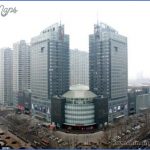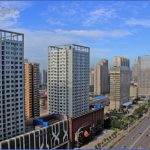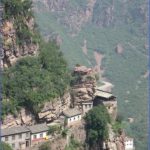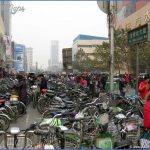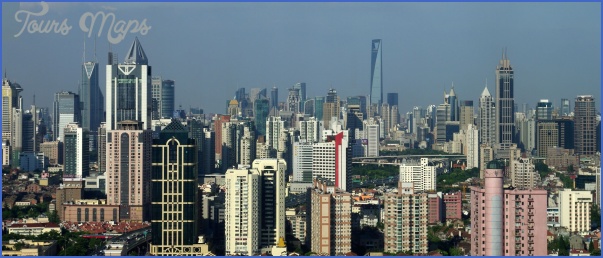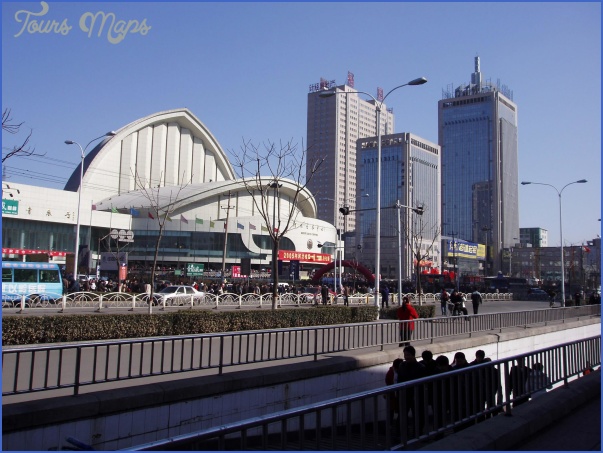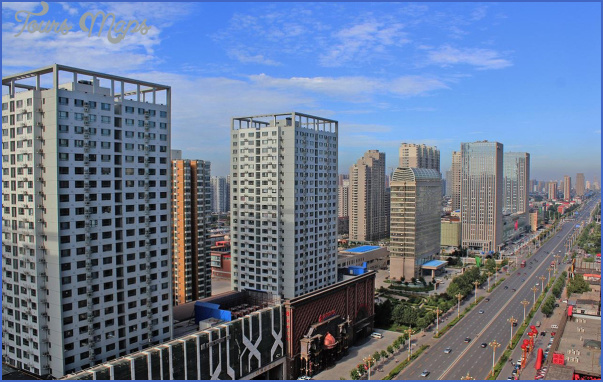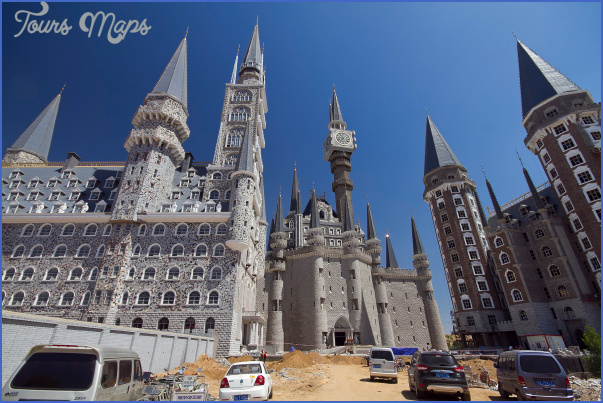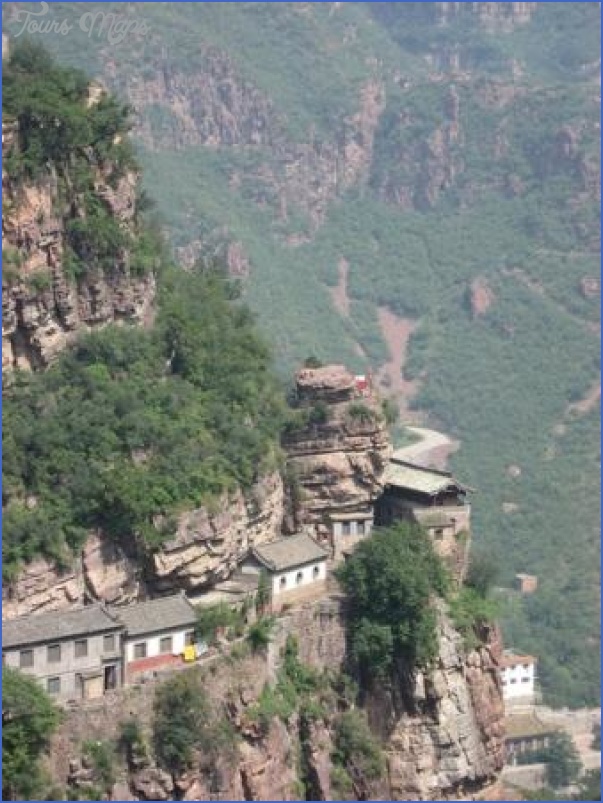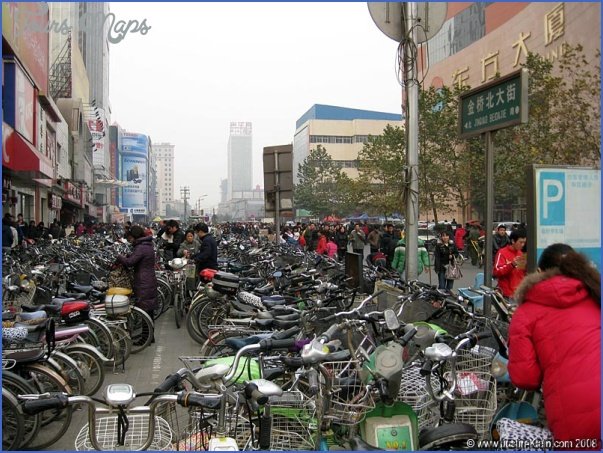Capital of the Province of Hebei
Area: 284sq.km/110sq. miles
Population: 1,300,000 (conurbation 1,710,000)
Shijiazhuang lies at 114°29’E and 38°N in the south-west of the Hebei province, 280km/174 miles to the south-west of Beijing, from where the city can be reached in 3 hours by train or by bus. The city also has an airport.
Until the beginning of the 20th c. Shijiazhuang was just an unimportant village. From 1902, when the railway from Beijing to Wuhan came into being, it gradually grew in size to become a small city. Five years later the building of a second railway between Zhengding and Taiyuan accelerated the expansion of Shijiazhuang. In 1926 it finally reached the size of a major city and in 1947 its name was changed to Shimen.
Since the end of the 1940s Shijiazhuang developed so quickly that it not only became the present political, economic and cultural centre of the Hebei province, but is now also one of the most important industrial metropolises in the north of China.
The hospital in the west ofthe city bears the name ofthe Canadian doctor Norman Bethune who was responsible for medical care in the Red Army during the revolution. The first senior consultant was Kortis, an Indian. In the hospital grounds are the Bethune and Kortis halls.
The Vairo Cana Temple, situated 10km/6 miles to the north-west of the city, dates from the Tang period (618-907). Ofthe many buildings in the former temple complex only two have been preserved, the Shakyamuni and the Vairocana Halls. The former has walls decorated with Buddhist frescos and houses a Shakyamuni statue. The Vairocan temple, rebuilt in 1342, contains an earthenware statue of the Buddha Vairocana, hundreds of wall-paintings representing scenes from paradise, hell and the mortal world and religious (Buddhist, Daoist, Confucian) and human figures (emperors, empresses, queens, ladies-in-waiting, etc.). All the statues and wall paintings date from the 14th c.
The Temple of Lavish Prosperity, erected in 586, is situated 14km/9 miles to the north-east of Shijiazhang in Zhengding. It is also known as the Great Buddha Temple (Dafo Si), because housed in the main building, the Dabei Ge, is a 22m/72ft high bronze statue of the Guanyin with 42 arms dating from 971.
In the temple complex, which measures about 50,000sq.m/59,800sq.yd, there are further historically important buildings of artistic interest. These include two pavilions each with an imperial stele, and the Moni Temple where five Buddhist earthenware statues dating from the Song era (960 1279) and a painted sculpture also modelled from earthenware of the goddess of mercy from the Ming period (1368-1644) are revered.
The monastery also contains a large collection of stone tablets with engraved prose texts, poems or portraits. The oldest engraving dates back to the 6th c.
The 51 m/56yd long Anji Qiao Bridge was built between 605-616 by Lu Chun from 28 blocks of stone. The colloquial name of the bridge, which lies 40km/25 miles to the south-east of Shijiazhuang in the district town of Zhaoxia, is Zhaozhou Qiao. It isthe oldest arched stone bridge in the world. The structure spans the river with a single arch 37m/40yd long and 9.6m/10yd wide. To relieve the strain on the main arch and to relieve the pressure ofthe water, the builder added two small arches to the end of each bridge with a width of about 3.80m/4yd-2.80m/3yd. The structure represents without doubt an innovation in bridge construction.
78km/48 miles to the west of the city rises the Green Rocks Mountain. Its slopes and the surrounding landscape are scattered with monasteries and temples dating from the 6th c. onwards. Of particular interest are the Temple of Good Fortune and Festivities (Fuqing Si) and the Palace ofthe Rainbow Bridge (Qiaolou Dian).
The Temple of Good Fortune and Festivities, probably of the Sui period (589-618), is dedicated to the daughter of the Sui emperor Yangdi. One of the main buildings, dating from the early Tang period (618-907), is the Hall of Princess Nanyang who converted to Buddhism following the death of her father. At the far end ofthe hall is a grotto which apparently served as the princess’s bedroom. Also kept in the temple, in addition to the painted earthenware statue of the princess, are ten statues of ladies-in-waiting playing old musical instruments. There is also a wall fresco portraying the conversion and life’s work ofthe princess, who became a nun.
The brick pagoda behind the temple dates from the late Ming period (1368-1644).
As its name implies, the Palace ofthe Rainbow Bridge, which belongs to the Temple of Good Fortune and Festivities, stands on a arched stone bridge 15m/16yd long and 9m/10yd wide; it is reminiscent of a rainbow with two steeply rising rock walls joining to meet each other. The bridge is 1400 years old, although the palace was not built until the middle of the 17th c. The two tombs in Mancheng dating from the time of the western Han (206 b.c.-a.d. 23) are situated about 150km/93 miles to the north-east of Shijiazhuang and are the last resting place of the prince Liu Sheng and his wife. The two underground mausoleums (a true reproduction ofthe residence of the ruling pair with bedrooms, living rooms, bathrooms, etc.), are 50m/164ft long, 38m/125ft wide and 7m/22ft tall. The two tomb chambers are covered by a hermetically insulating sheet of cast iron. The clothes on both the bodies are made from small pieces of jade, held together with gold thread (the prince’s have 2498 jade pieces and 110Og of gold thread, the princess’s have 2160 jade pieces and 600g of goldthread). Also discovered in the tomb is an extremely charming gilded bronze statue, 48cm/18in. high, of a kneeling lady-in-waiting holding a lamp. By this specimen the direction and the strength ofthe light could be regulated. A further priceless addition to the grave goods is a bronze incense-burner which has picture subjects with gold thread running through them; they portray towering mountain ranges on the far side of a sea.
Shijiazhuang Photo Gallery
Maybe You Like Them Too
- The Best Cities To Visit in The World
- World’s 10 Best Places To Visit
- Coolest Countries in the World to Visit
- Travel to Santorini, Greece
- Map of Barbados – Holiday in Barbados



